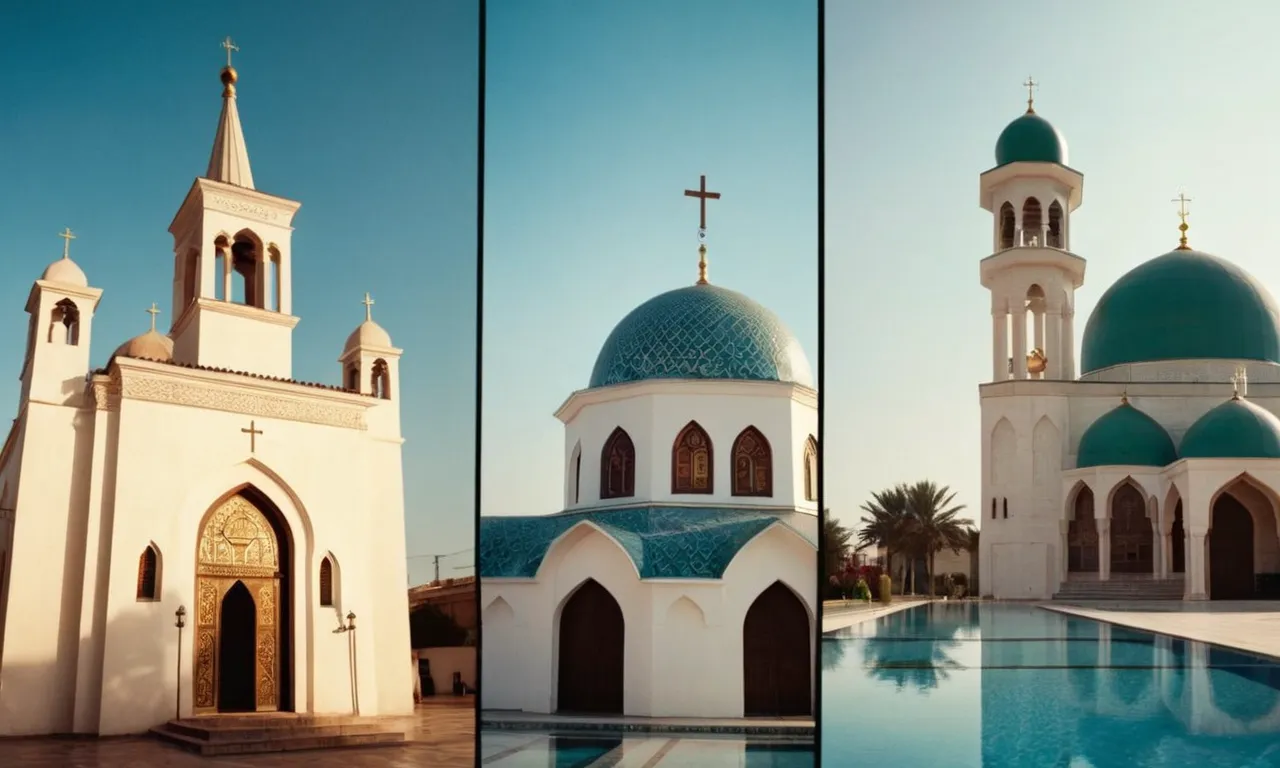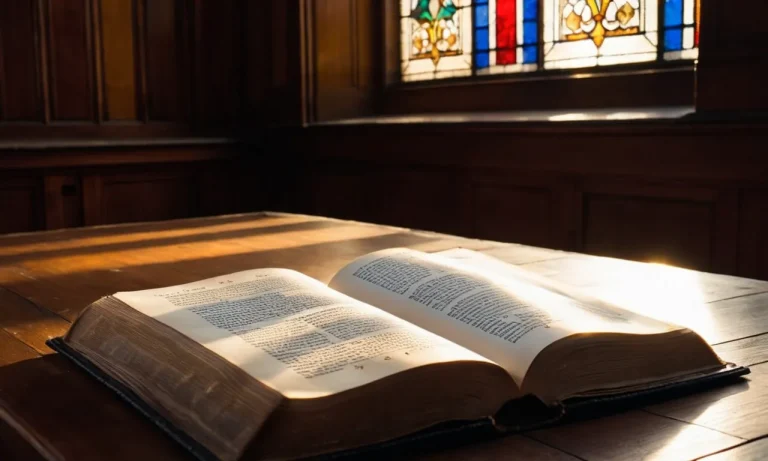Comparing Christianity And Islam: Beliefs, Practices, And History
Christianity and Islam are two of the world’s largest religions with over 2 billion followers each. Both trace their roots back to Abrahamic traditions and have shaped much of world history over the past two millennia.
If you’re short on time, here’s a quick answer to your question: Christianity and Islam share similarities in belief in one God and place importance on helping those in need. However, Christianity believes Jesus to be the son of God while Islam considers him only a prophet.
Christianity has the Bible, Islam has the Quran. Practices like worship services and holidays vary greatly as well between the two faiths.
In this comprehensive guide, we will dive deeper into the similarities and differences between Christianity and Islam when it comes to origins and history, central religious texts, beliefs about God and prophets, worship practices and rituals, interpretations and denominations within each faith, geographic reach and demographics, impacts on society and culture, and more.
Origins and Early History
Jesus and early Christianity
Jesus Christ was born around 4 BC in Judea (modern-day Israel/Palestine). Jesus traveled around preaching his gospel message of love, forgiveness, and humility. He gathered a group of disciples and performed miracles, such as healing the sick.
Around AD 30, Jesus was crucified in Jerusalem under the order of Pontius Pilate. His followers believed he was resurrected three days later. The earliest followers of Jesus were Jews who continued to practice Judaism, but soon non-Jews (Gentiles) also joined the Jesus movement. After Jesus’ death, his apostles helped spread Christianity to different parts of the Roman Empire. Major figures in early Christianity were Peter, Paul, James, and John.
Muhammad and early Islam
The prophet Muhammad was born around 570 AD in Mecca in Arabia. In 610, at about age 40, he started receiving revelations from God through the angel Gabriel. These revelations were compiled into the Quran, Islam’s sacred text. Muhammad gained a small following in Mecca but faced persecution.
In 622, he migrated with his supporters to Medina. This event marks the beginning of the Islamic calendar. In Medina, Muhammad’s followers grew rapidly. They defeated the Meccans in 630 and took control of Mecca. After Muhammad’s death in 632, his followers spread Islam through military conquests under the Rashidun and Umayyad Caliphates.
Spread of Christianity in Europe and Byzantine Empire
In the 4th century AD, Emperor Constantine legalized Christianity in the Roman Empire. Christianity became popular across Europe in the following centuries. Missionaries helped convert pagan Germanic tribes like the Franks, Visigoths, and Anglo-Saxons. In the 5th century, St. Patrick introduced Christianity to Ireland.
The religion continued spreading into Northern Europe over the following centuries. Meanwhile, the Byzantine Empire centered in Constantinople became a major Christian center. Its magnificent Hagia Sophia cathedral was completed in 537 AD.
Rise and spread of Islam under Rashidun and Umayyad Caliphates
After Muhammad’s death, his successor Abu Bakr became the first caliph (leader) of the Rashidun Caliphate. Under the Rashidun Caliphs, Islamic armies conquered the Persian Empire and large parts of the Byzantine Empire, including Syria, Egypt, and North Africa.
The Umayyad Caliphate continued expanding Islamic rule into Europe and Asia from 661-750 AD. At its peak, the Umayyad Caliphate stretched from Spain to India. Muslim forces crossed the Strait of Gibraltar and began conquering the Iberian Peninsula in 711.
In 732, they were defeated by the Franks at the Battle of Tours in modern-day France. This halted Muslim expansion into Europe from the southwest.
Central Religious Texts: The Bible and Quran
Contents, themes and narrative style of Bible vs Quran
The Bible and Quran have some broad similarities but also key differences. The Bible is longer and composed of 66 separate books written by over 40 authors over 1500 years. The Quran is a single book authored over 23 years.
The Bible includes various literary styles – history, prophecy, poetry, letters. The Quran has a uniform poetic style throughout. Both are viewed as divine revelation by believers but the Bible stories tend to be more descriptive narratives while the Quran chapters teach theological principles.
Major themes across both include God’s nature, human purpose, righteousness, sin and judgment, and future restoration. But while the Bible progresses chronologically towards a redemption climax in Jesus, the Quran recycles many Bible accounts to illustrate core Islamic beliefs in the one God (Allah) and Muhammad as the last prophet.
The Bible trajectory is creation, fall, redemption, consummation – the Quran focuses more singularly on maintaining correct theology and practice.
Literalist vs progressive/contextual interpretations
Most evangelical Christians interpret the Bible literally or conservatively. This means believing the text as historical fact and deriving absolute moral laws from the content. Progressive Christianity instead sees the Bible as a contextual document that must be interpreted based on updated understanding and application.
Islam has a similar spectrum in approaching the Quran. Islamist literalism strictly adheres to 7th century edicts and models in the text. Progressive Muslims argue for contextual adaptation of Quranic principles in modern society.
Key differences center around biblical criticism, women’s issues, and violence. Conservative interpreters reject analyzing or questioning the scriptures’ divine origins while liberals approve scholarly critiques.
Concerning gender, conservatives oppose female leadership and LGBTQ identities based on traditional interpretations where progressives promote full equality. Regarding violence, literalists justify aggression or holy war based on ancient biblical battles or Muhammad’s wars.
But reformers argue these violent aspects were situational and instead focus on the texts’ peaceful themes.
Translations and versions of scriptures
The multiplied Bible translations reflect disagreement over rendering the ancient Hebrew and Greek most accurately. Word-for-word translations (NASB, KJV) try to mirror the original languages closely. Dynamic equivalence Bibles (NIV, NLT) translate concepts thought-for-thought for clarity.
Catholics and Protestants also differ in their biblical contents – Catholic versions include the Apocrypha.
The Quran presents unique translation challenges as Muslims consider the Arabic language sacred. Many argue only the original Arabic version preserves the literal divine message. Leading English versions like Pickthall, Yusuf Ali, Shakir aim to communicate the essential meanings understandably while indicating variant options.
Significant efforts have been made recently to offer native African and Asian Muslim language translations.
Beliefs about God, Jesus, Prophets and Angels
God/Yahweh/Allah – Trinitarian vs Unitarian view
Christianity believes in one God existing as three divine persons – God the Father, Jesus the Son, and the Holy Spirit. This is known as the Trinity. Islam strictly maintains God’s oneness and rejects the Trinity as well as Jesus’s divinity. Allah is the standard Arabic word for God used by Muslims.
Though God in Christianity and Allah in Islam refer to the same Abrahamic God, there are different theological conceptions.
Jesus in Christianity vs Isa in Islam
For Christians, Jesus is the divine Son of God, part of the Trinity, who died for humankind’s sins and rose again. Muslims view Jesus (Isa in Arabic) as a major prophet, born of a virgin birth, but not divine.
They believe Jesus ascended to heaven without being crucified and will return to defeat the Antichrist near the Day of Judgment.
Status of Biblical prophets and Muhammad
Many prophets like Abraham, Moses, and David are recognized in both religions. But Christianity sees Jesus Christ as superior to all past prophets and the fulfillment of biblical prophecy. In Islam, Muhammad has the supreme status among prophets as God’s final messenger who received the entirety of divine revelation in the Quran.
| Status in Christianity | Status in Islam |
| Jesus Christ: Son of God, divine | Jesus (Isa): Major prophet but not divine |
| Muhammad: Not part of biblical prophecy | Muhammad: Final and supreme prophet |
An estimated 33% of the world’s population follows Abrahamic monotheism – Christianity (31.11%) and Islam (24.1%) as per Pew Research Center.
Angelology – cherubim, seraphim vs archangels like Jibril
Both faiths have beliefs in angels like Gabriel. In Christianity detailed angelic hierarchy exists like seraphim, cherubim etc. with guardian angels protecting each believer. In Islam, angels follow Allah’s commands and the Archangel Gabriel (Jibril) transmitted the Quran.
The Islamic version focuses more on angels closeness to God than an elaborate hierarchy.
Worship Practices and Rituals
Church and mosque architecture over time and geography
Both churches and mosques have evolved architecturally over time to meet the needs of growing congregations. Early churches were simple, with open layouts focused around the altar. Gothic cathedrals later incorporated towering spires, stained glass, and more ornamentation.
Mosques originally had open courtyards and prayer halls, emphasizing simplicity, but later incorporated intricate geometric and floral designs. Architectural styles adapted to local cultures so churches and mosques display great regional diversity.
Yet across eras and geographies, these buildings retain core elements reflecting their purpose as sacred community spaces.
Prayer rituals – Lord’s Prayer vs 5 daily salah facing Mecca
Christians commonly recite the Lord’s Prayer, as taught by Jesus in the Bible (Matthew 6:9-13). It acknowledges God’s holiness, asks for His will to be done, requests daily bread, and seeks forgiveness and deliverance from evil.
Muslims have five mandatory daily prayer times, always reciting prayers in Arabic facing the holy city Mecca. Before prayer, they ritually purify themselves. These salah prayers involve repeating verses from the Quran and cycles of standing, bowing, and prostrating.
| Christianity | Islam |
| Lord’s Prayer | 5x daily salah prayers |
| Recited in native languages | Recited in Arabic |
| Facing varies | Facing Mecca is required |
Important celebrations like Christmas and Ramadan
Christians commemorate Jesus Christ’s birth on December 25th with gift-giving, special church services, family meals, and more. The season leading up to Christmas sees nativity displays in homes and public spaces, Christmas music, and general festivity.
Muslims have an intense spiritual season called Ramadan—a month of fasting during daylight hours to grow closer to God and show care for less fortunate people. It culminates in Eid al-Fitr, a joyous feast celebrating the revelation of the Quran to Muhammad.
Dietary restrictions – fasting, no pork or alcohol vs halal rules
Many Christians practice Lenten fasting or occasional individual fasts while Muslims fast dusk to dawn during the Ramadan month. Christians also commonly avoid certain intake on Fridays or during other fasts – meat, alcohol, etc.
Muslims have more extensive dietary restrictions as part of “halal” guidelines. Pork and alcohol are always prohibited. Other meats must be prepared according to ritual slaughter practices. Fasting develops spiritual discipline, self-restraint, and obedience to God in both faiths.
Interpretations and Major Denominations
Catholic, Protestant and Orthodox churches
Christianity has three main branches: Catholicism, Protestantism, and Orthodoxy. The Catholic Church is the largest Christian denomination, representing over 50% of all Christians globally. It is headed by the Pope and has a hierarchical structure.
Key beliefs include apostolic succession, the authority of church tradition, seven sacraments, and veneration of Mary and the saints.
Protestantism emerged in the 16th century Reformation, rejecting papal authority and Catholic doctrines and practices not based on the Bible alone. Major Protestant denominations include Lutherans, Anglicans, Baptists, Methodists, and Presbyterians.
They emphasize scripture rather than tradition, focus on faith over works, and differ on issues like church governance and sacraments.
Eastern Orthodoxy is the third main branch, originating in the Great Schism of 1054 when it split from the Catholic Church. The Orthodox churches are organized as independent units based on location, emphasizing sacramental, mystical theology and ascetic disciplines.
Key differences from Catholicism include allowing married priests and disagreements over papal primacy.
Sunni and Shia divisions, other Muslim denominations
The two main denominations of Islam are Sunni (80-90% of Muslims) and Shia (10-20%), which split after disagreements over succession following Prophet Muhammad’s death. Sunnis believe leaders should be elected, while Shias believe authority lies with Muhammad’s descendants.
Key theological differences relate to concepts of religious authority and ritual practices.
Other denominations like Ibadi, Ahmadiyya, and Sufism also exist. Ibadis separated early in Islamic history and are now mainly in Oman and parts of Africa. Ahmadiyyas, founded in the 19th century, are considered heretical by mainstream Muslims.
Sufism emphasizes mysticism and spiritual depth over legalism.
Heresies, reformations and movements within
Throughout history, various heresies and reform movements have also emerged within Christianity and Islam. Major Christian heresies in early history included Arianism, Nestorianism, and Pelagianism, which the Church condemned at ecumenical councils.
Reformation movements like Lutheranism, Anglicanism, Anabaptism, and Calvinism led to permanent divisions in doctrine and structure.
In Islam, movements like the Mu’tazila rationalists and various schools of Islamic theology were influential. Later movements include Wahhabism originating in the 18th century, which takes a strict stance on doctrine and religious practice.
Both faiths continue to experience dynamic internal movements seeking to reform or revive theological perspectives.
Reach, Demographics and Statistics
Global distribution and population concentrations
Christianity and Islam are the two largest religions in the world, together accounting for more than half of the global population. While Christianity originated in the Middle East, it has spread across the globe and today has the most adherents in Europe and the Americas.
Islam emerged in the Arabian Peninsula and remains concentrated in the Middle East and North Africa, as well as parts of Asia.
According to estimates, there are about 2.5 billion Christians worldwide, making up around 31% of the global population. The regions with the highest concentration of Christians include Europe (74%), North America (71%) and Latin America and the Caribbean (89%).
On the other hand, there are around 1.9 billion Muslims worldwide, comprising about 24% of the global population. The Middle East-North Africa region has the highest percentage of Muslims (93%), followed by the Asia-Pacific region (24%).
Ethnicity, immigration and cultural assimilation
While Christianity and Islam have ethnic roots in the Middle East, both religions have expanded well beyond their regions of origin and have assimilated into diverse cultures worldwide. Christianity found early adherents among Jewish converts but soon spread to Gentiles in the Greco-Roman world.
Islam emerged among the Arabs but quickly took root across the Middle East and North Africa following Muslim conquests.
In modern times, Christianity remains prevalent in Europe and the Americas due to a history of colonization and missionary work. At the same time, Islam has grown in parts of Asia and sub-Saharan Africa through trade and migration.
Both religions have gained followers through immigration to Western nations. While some tension exists, most Muslim immigrants have assimilated into Western, predominantly Christian societies.
Growth trends and projections
According to projections by the Pew Research Center, the global Muslim population is expected to grow at double the rate of the non-Muslim population between 2015-2060, largely due to higher fertility rates.
The Muslim population could increase from 1.8 billion in 2015 to 2.8 billion by 2050, representing about 30% of the global population. In contrast, the non-Muslim population is projected to grow at a slower rate, reaching 9.3 billion by 2060.
Pew predicts the global Christian population will remain relatively stable over the same period, hovering around 31% of the world’s population through 2060.
While the share of Christians worldwide is expected to decline slightly due to slower growth, Christianity will continue to remain the largest religion. Regionally, the share of Christians is projected to decline in North America and Europe due to secularization and religious switching, while increasing in sub-Saharan Africa due to high fertility rates and religious switching to Christianity.
Islam will see growth across North Africa, the Middle East and parts of Asia. Overall, both Christianity and Islam will continue to boast over 1 billion followers each well into the second half of the 21st century.
Impacts on Society, Culture and Politics
Influences on morality, laws, education, arts and literature
Both Christianity and Islam have profoundly influenced morality, laws, education, arts, and literature throughout history. The Bible and Quran provide guidance for moral living, and Christian and Islamic ethics have shaped legal systems worldwide.
For example, the Ten Commandments and Golden Rule have influenced laws prohibiting murder, theft, and slander across many Christian-majority societies. Similarly, Islamic Sharia law is based on Quranic principles like justice, charity, and respect for human life.
Education in Christian and Muslim societies often includes religious instruction and studying scriptures. Christian monasteries preserved ancient texts during the Middle Ages, while Islamic madrasas taught subjects like theology, law, literature, and science.
In art and literature, Christian themes and stories pervade Western works from Michelangelo’s paintings to Dante’s Inferno, while Islamic styles like intricate geometric patterns and calligraphy ornament mosques and books.
Major works of Christian and Muslim philosophy have also analyzed the intersection of faith and reason.
Islamic golden age of science and civilization
From the 8th to 13th centuries, the Islamic world experienced a golden age of science and civilization. Muslim scholars significantly advanced knowledge in areas like mathematics, astronomy, medicine, chemistry, and optics, building on ancient Greek, Persian, and Indian learning.
For instance, the mathematician al-Khwarizmi developed algebra and algorithms. The scientist Ibn al-Haytham pioneered the scientific method and made breakthroughs in optics. Physician Ibn Sina (Avicenna) wrote an influential medical encyclopedia.
Major Islamic cities like Baghdad, Cairo, and Cordoba became thriving cultural centers with libraries, hospitals, and universities that attracted diverse scholars. This golden age flourished under Abbasid and Umayyad caliphates when Islamic rulers actively sponsored scientific research and scholarship.
It helped spread ideas and knowledge between the Muslim world, Christian Europe, India, and China. Although the golden age declined by the 13th century, its intellectual legacy influenced later progress in science and technology.
Complex Interactions and Histories between Faiths
Despite clashes between their communities historically, Christianity, Islam, and other faiths have also profoundly influenced one another through complex cultural interactions. For centuries, Christian Europe and the Muslim Middle East maintained diplomatic, economic, and intellectual contact through trade, the Crusades, and exchange of ideas.
Christianity draws on Jewish roots while Islam sees Jewish and Christian prophets as part of its lineage of revelation. Concepts like monotheism, prophets, divine books, angels, and the Last Judgment are shared across the Abrahamic faiths.
Mystic traditions have also transmitted theological ideas between faiths. Architecture and arts have exchanged influences as seen in Islamic-inspired design in Spanish Christian buildings. While conflicts also occurred, Muslims allowed Christian worship in Jerusalem under their rule during the Middle Ages.
Peaceful coexistence and cooperation prevailed for long periods, as in the diversity of Moorish Spain. In the 21st century, dialogue between Christian and Muslim leaders continues on issues like humanitarian and social justice causes.
Conclusion
In summary, while Christianity and Islam share the common roots of Judaism and many core theological beliefs, their doctrines diverged significantly after the 1st century CE lives of Jesus and 7th century Muhammad.
Their scriptures narrate different versions of early spiritual history in the Levant region. Christianity sees Jesus as part of the Godhead, Islam considers him only a human prophet preceding Muhammad.
While both value faith, good works and peace, observant practices like worship ceremonies and lifestyles vary. Through periods of conflict as well as interfaith cooperation and exchange of ideas over two millennia, the two religions have profoundly shaped the course of human civilization.







